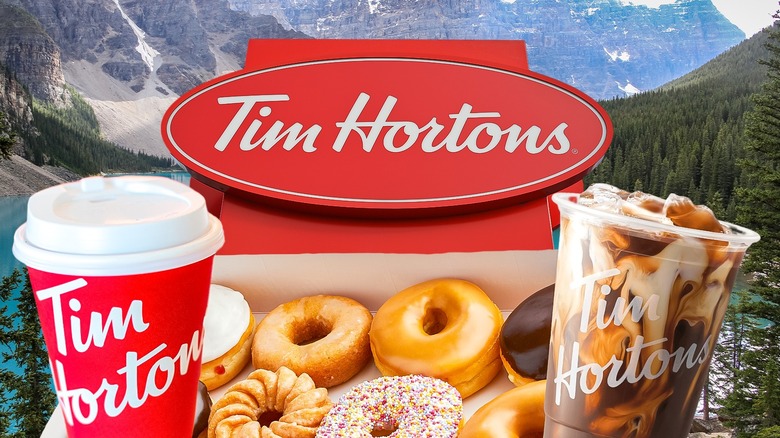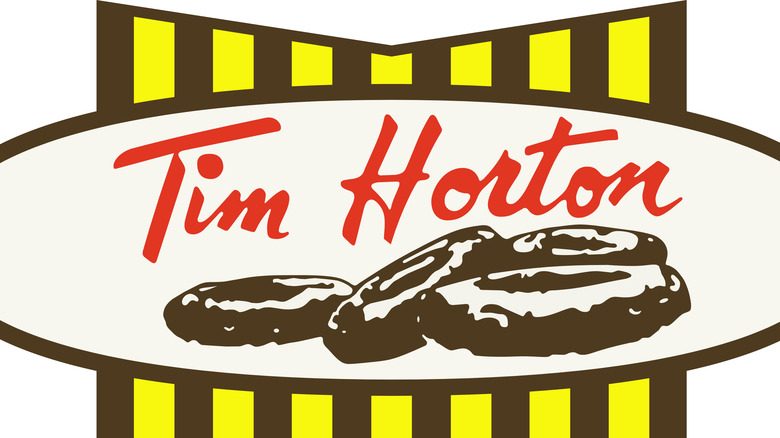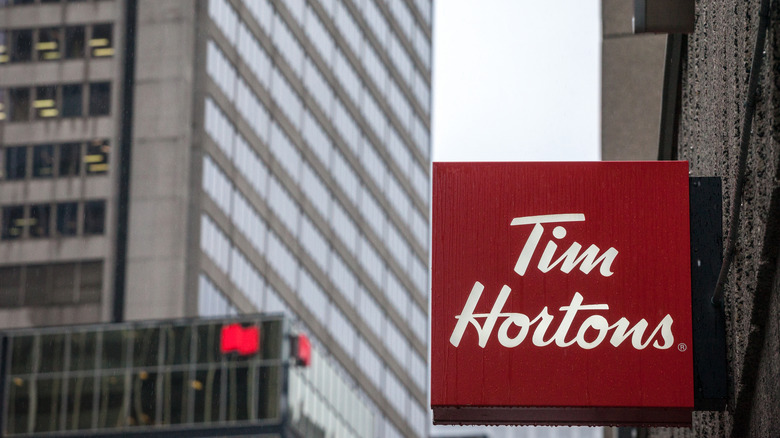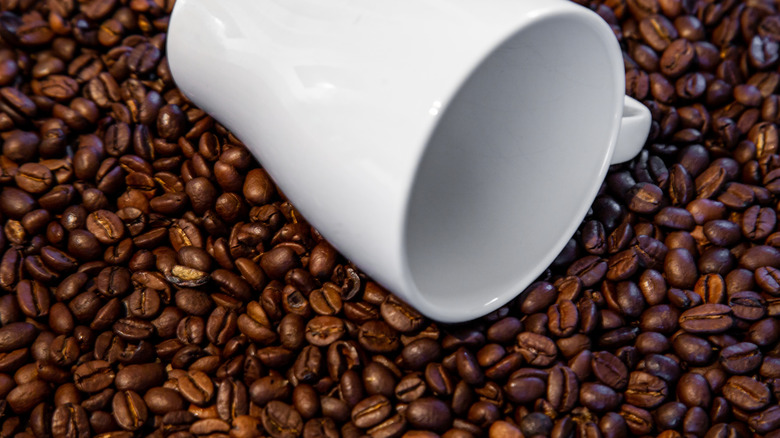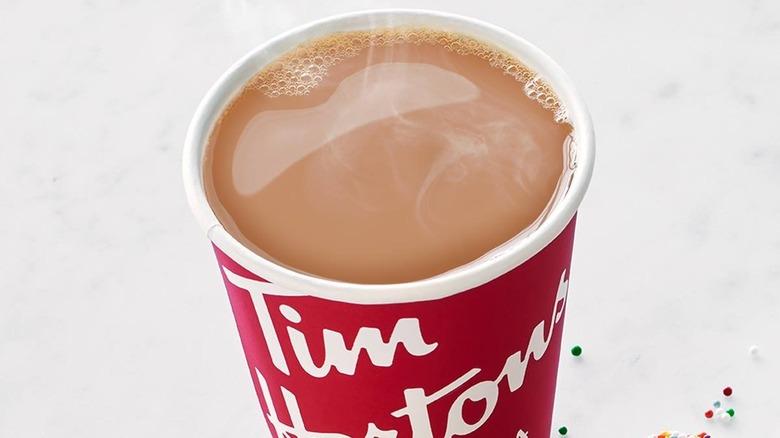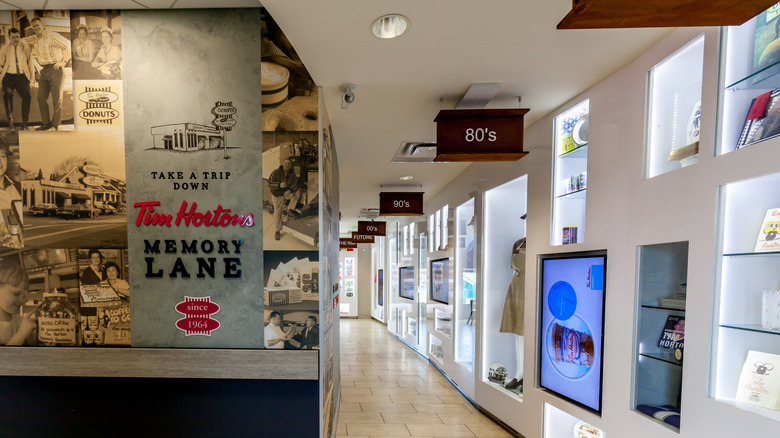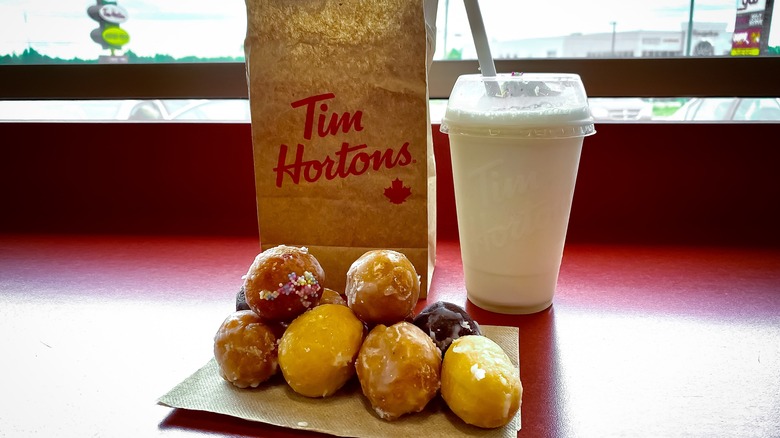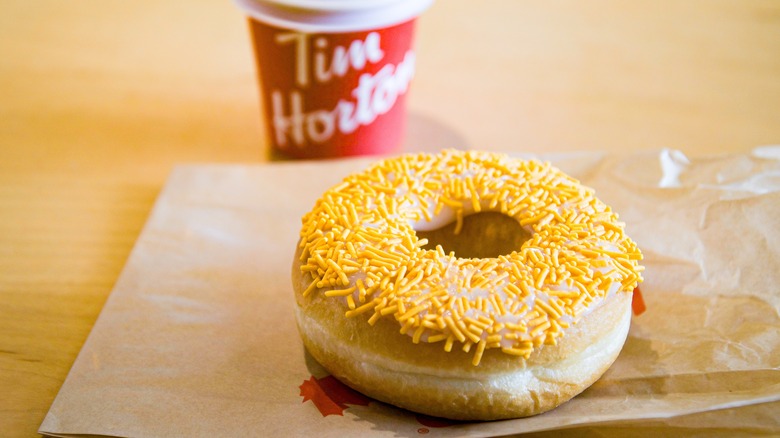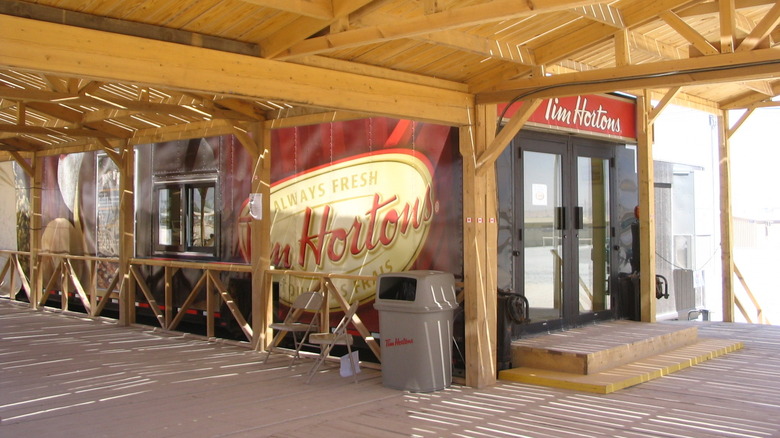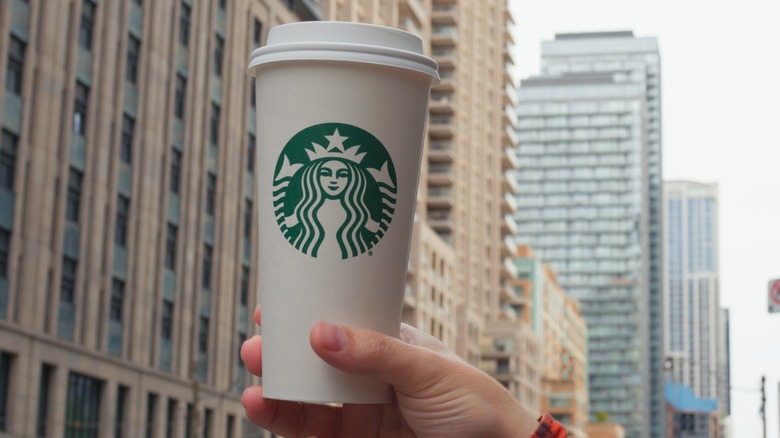12 Facts You Should Know About Tim Hortons
Whether it's affectionately shortened to Tims, Timmy's, or Timmies, there is no denying that Tim Hortons has cemented itself among the top breakfast chains around the world. Founded in 1964 in the port city of Hamilton, Ontario, it has grown into Canada's biggest coffeehouse and quick-service food chain, according to Franchise Canada. That's because it boasts about 4,000 locations across 13 Canadian provinces and territories, not to mention 869 branches across the United States.
Its faithful customers don't just come in for the hot coffee, though. The brand also serves shakes and iced coffee drinks, sandwiches and wraps, soups and hot bowls, and plenty of baked goods, from donuts to muffins and croissants.
While some facts pertaining to this successful brand are common knowledge — such as its founder being a legendary hockey player — there are quite a few tidbits that might amuse or surprise you. Here is some interesting trivia about Tim Hortons.
The coffee is rumored to contain nicotine and MSG
Coffee is one of the most widely consumed beverages in North America. In fact, a whopping 400 million cups are ingested daily in the U.S., per Balance Coffee. North of the border, it seems that 71% of Canadians drink coffee regularly, thus making the latter more popular than water, according to Made in CA. With these numbers in mind, it was only a matter of time before some people started blaming that habit on Tim Hortons specifically, accusing its coffee items of containing traces of nicotine, as well as MSG (though whether MSG is bad for you is debatable). However, the idea that "Tims" coffee contains nicotine is one of the many myths about fast food restaurants you can stop believing.
As it turns out, this bizarre conspiracy is completely unfounded, largely due to the Canadian Food Inspection Agency's extremely strict rules as far as "food labeling," "preventable food safety hazards," "food fraud," and "food-related complaints" are concerned. Such an agency would never allow nicotine, even in negligible doses, to be ingested in that deceptive manner. That's because nicotine may have harmful effects on health, such as cancer, or respiratory, reproductive, and gastrointestinal problems.
In an effort to dispel that nasty rumor, Tim Hortons has dismissed the issue on its website with: "This urban myth is just that ... a myth! ... There is absolutely NO nicotine or MSG in our coffee." Perhaps all those repeat clients are simply "addicted" to the brand's own blend of premium-quality Arabica beans.
What the donuts in the original logo represent
The brand was co-founded by Miles Gilbert "Tim" Horton, who was a defenseman in the National Hockey League from 1948 until his death in a sports car crash in 1974. He opened the first Tim Horton Donuts store on 64 Ottawa Street North, in Hamilton, Ontario, which only served coffee and donuts at the time.
Everyone is familiar with the chain's current logo, which came to be in 2017 and features its dark red name in cursive over a white background. The original logo, though, which was adopted from 1964 until 1985, was quite different. It consisted of two ovals: the top one was white and featured "Tim Horton" in bright red above an image of four chocolate and cream donuts. As for the bottom oval, it was yellow, with an all-caps "DONUTS" in brown. Later, from 1985 till 1991, the "DONUTS" was replaced with "ALWAYS FRESH."
Those four original donuts weren't there by accident; they symbolized people who were very dear to the founder's heart: his four daughters from his wife Lori Michalek, named Kim, Jeri-Lyn, Tracy, and Kelly.
Shouldn't there be an apostrophe in the name?
As per English grammar rules, the brand's name should be spelled "Tim Horton's," right? That would have been in effect if it weren't for a certain law in the French-speaking province of Quebec. In 1977, the Charter of the French Language, also known as Bill 101, was issued there, and it's still in effect. It dictates that French should be the exclusive language of businesses across the entire area, be they for profit or not. Those who don't comply risk paying heavy fines.
Rather than be penalized or deal with two different logos in the same country, the franchise has chosen to make do without the apostrophe, simply adding an "s" at the end of its name. "Tims" knows better than to push English grammar on a province that now houses 559 of its restaurants, i.e., about 16% of the total number of branches in Canada, according to Scrape Hero.
An elaborate process from crops to massive taste tests
What's so special about Tim Hortons' coffee? According to a statement on the website, "We are relentless in our pursuit of the perfect cup. There is an incredible attention to detail through the different steps along the way in the journey from the tree to a cup of Tim Hortons coffee."
Indeed, that process seems long and meticulous. It starts with selecting premium beans from small coffee farmers in countries renowned for that crop, such as Colombia and Guatemala, as long as they're "grown in different micro climates with rich soil and higher altitudes." The beans are then blended and roasted by master specialists, before going through the ultimate tasting phase. In fact, as per the brand, over 75,000 coffee cups are taste-tasted every year in an effort to maintain both flavor and quality.
This popular menu item is now featured in the dictionary
This quick-service chain has grown to be a major component of Canadian identity, serving more than five million cups of coffee daily. The company website claims that 80% of Canadians visit a Tim's location in their country at least once a month. As for the most ordered items on the menu, they include the Original Blend and the Double-Double coffees, as well as the Timbits (bite-sized round confections).
The Double-Double consists of a hot original brewed coffee blended with two packs of sugar and two shots of cream. Despite its simplicity — or maybe because of it –, it somehow made its way to the Canadian Oxford Dictionary in 2004. Here is what the entry says:
"Double-double: noun. A cup of coffee with a double amount of both cream and sugar. I cannot start the day without my double-double."
Now that's a little impressive.
Tim Hortons made a personalized mug for this Hollywood star
Tim Hortons has teamed up with several celebrities to promote its name across the globe. In 2021, for instance, singer Justin Bieber was signed to introduce three new Timbit flavors, the Timbiebs, in addition to related merchandise. Per CBC, the artist stated, "Doing a Tim Hortons collab has always been a dream of mine. I grew up on Tim Hortons, and it's always been something close to my heart."
Sometimes, though, these collaborations happen by accident. In 2013, while he was promoting his movie "Gangster Squad," Canadian actor Ryan Gosling expressed in an interview his wish to receive a merchandise cup similar to the Dick Tracy Burger King cups he used to collect. After the reporter suggested a Tim Hortons cup, the actor lit up and asked, "Can we get a Tim's mug for "Gangster Squad," please?" Soon after that, his fan, a then-Buffalo.com writer named Sarah J. Velasquez, made a fake green Gosling Goblet and shared it online.
Inspired by this initiative, the Tim Hortons account tweeted, "Hey @RyanGosling, we heard you wanted your face on a Tim's cup... We'll see what we can do." The brand subsequently issued two white personalized mugs and sent them to both Gosling and Velasquez. Unfortunately, one copy was delivered broken, as the writer tweeted, "@UPS destroyed a rare mug and my dreams. I hope @RyanGosling's delivery makes it in one piece." She then commented, "If there's one mug you don't want to break, it's this one."
The brand has its own museum
There are 66 Tim Hortons branches in Hamilton alone, the brand's birth city. One of them, located at 65 Ottawa St N, is a renovated building of the very first store. That's just one of the things that makes it special. Another is the Tim Hortons Museum, which has been housed on the second floor since 2014. This attraction is open daily from 5 a.m. to 10 p.m., and it can be accessed for free with your food and beverage orders in hand.
This specialty museum is currently listed on TripAdvisor at No. 48 of "245 things to do in Hamilton," with a rating of four bubbles. It features a "memory lane" housing machines, uniforms, menu items, brochures, signs, awards, and merchandise, divided by decade.
Nostalgic customers and sports fans alike would also be pleased to learn that there's a museum dedicated exclusively to Tim Horton as a beloved hockey player. It displays family photos and game-worn jerseys, among other rare items. You can access it inside the Tim Horton Events Center in his hometown of Cochrane, located at 7 Tim Horton Drive.
Cold and iced drinks make up 40% of the brand's sales
According to the Financial Post, in 2023, Tim Hortons' global quarterly sales exceeded $2 billion for the very first time. A big part of that success may be due to consumers ordering more and more cold and iced beverages from the brand. The "Tims" cold specialty beverages include a blended frozen coffee, frozen drinks made from real fruit juices and purees, and fruit smoothies containing creamy Greek yogurt. As it turns out, it was the classic Tims Iced Capp that was the brand's most popular cold drink of 2023.
In the article "Coffee chains are betting big on cold drinks as Gen Z turns its back on old-school coffees," Business Insider reveals that cold beverages now make up 40% of drink sales across Tim Hortons' Canadian locations. In fact, many Canadian fast food brands believe that the overall boom in cold brew orders will not wane anytime soon and will probably grow even more in the future.
The donuts are so good they affect consumption stats
Tim Hortons offers several snacks and baked goods, from muffins to cookies, bagels, and croissants. Sold single, by the half-dozen, or the dozen, the donuts are baked in situ daily and in small batches to insure freshness, as per the website. Varieties include the apple fritter, chocolate dip, chocolate glazed, Canadian maple, blueberry, and salted caramel.
Canadians, not Americans, consume more donuts per capita than any other country, and it's largely thanks to Tim Hortons. As a matter of fact, in 2023, after the brand had added more fruit pieces to the recipe, the apple fritter dethroned the Boston Cream as the country's favorite donut.
The numbers speak for themselves when it comes to the Canadians' love of donuts. Per Reader's Digest Canada, they consume 1 billion donuts annually. To be a bit more specific, it's Lloydminster, in Alberta, that's the nation's capital of donut consumption, despite having only three Tim's locations.
Some of the staff trained for potential attacks in Kandahar
Outside North America, the Middle East houses the most Tim Hortons branches in the world, with 300 across the GCC. Contrary to common belief, this part of the planet is actually very diverse. It spans three continents and features a wide array of religions, languages, ethnicities, cuisines, climates, and political regimes. Nonetheless, the coffee culture is strong pretty much in every nation as a hospitality staple.
Some Middle Eastern countries have witnessed political unrest and armed conflicts for years, including Afghanistan. As a gesture for the Canadian soldiers stationed there in 2006, Tim Hortons established a trailer in an airfield in Kandahar, the infamous Taliban center. To keep them alert and protected, 70 potential staff members underwent a rigorous training on top of their barista and baking chores. They were taught how to react in case of a nuclear disaster, land mines, a hostage situation, or a biological weapon.
Tim Hortons vs. Starbucks
According to Scrape Hero, Starbucks is the largest coffeehouse chain in the U.S., followed by Dunkin' Donuts, and then Tim Hortons. Tim Hortons' biggest presence is in the state of New York, with about 256 restaurants — which make up 39% of all "Tims" branches in the country.
In Canada, though, Tim Hortons is the most popular coffee chain, with various small local businesses coming in second place, and Starbucks only nailing 18% of the consumers' votes, per Twentify. Tim's loyal fans justified their choice in the latter survey by highlighting its consistency in flavor, quality/price ratio, and continuous environmental initiatives.
Medium points out that Tim Hortons' popularity over Starbucks in Canada is largely because the former exudes a more welcoming atmosphere and the latter's prices are typically higher. Another essential factor is the glaring lack of donuts on the Starbucks menu.
A sitcom episode resulted in limited-edition items
Narrated by the late Bob Saget, the popular American sitcom "How I Met Your Mother" aired for nine seasons from 2005 till 2014. One of its running gags is that it often poked fun at Canadians, including their obsession with Tim Hortons. That's because one of the main characters, Robin (played by Canadian actress Cobie Smulders), is from Canada herself.
In an episode from Season 8 titled "P.S.: I Love You," "Beverly Hills, 90210" alumni Jason Priestley (a Canadian-American actor and director) guest-starred as himself. His character bragged that Tim Hortons had created a Timbit inside a strawberry-vanilla donut in his honor and called it "The Priestley."
The brand was so amused by this scene that it tweeted its release of a limited Priestly batch. It even created a second version in 2014, tweeting, "We can't wait to see you for #TimsDuellingDonuts @Jason_Priestley! We made you something... "The Priestley 2.Dough!"
